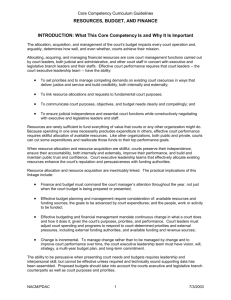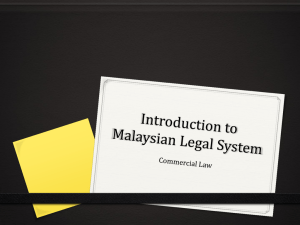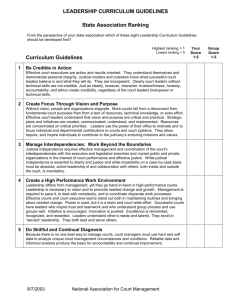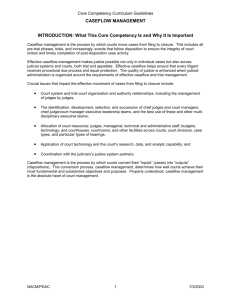Information Technology Management
advertisement
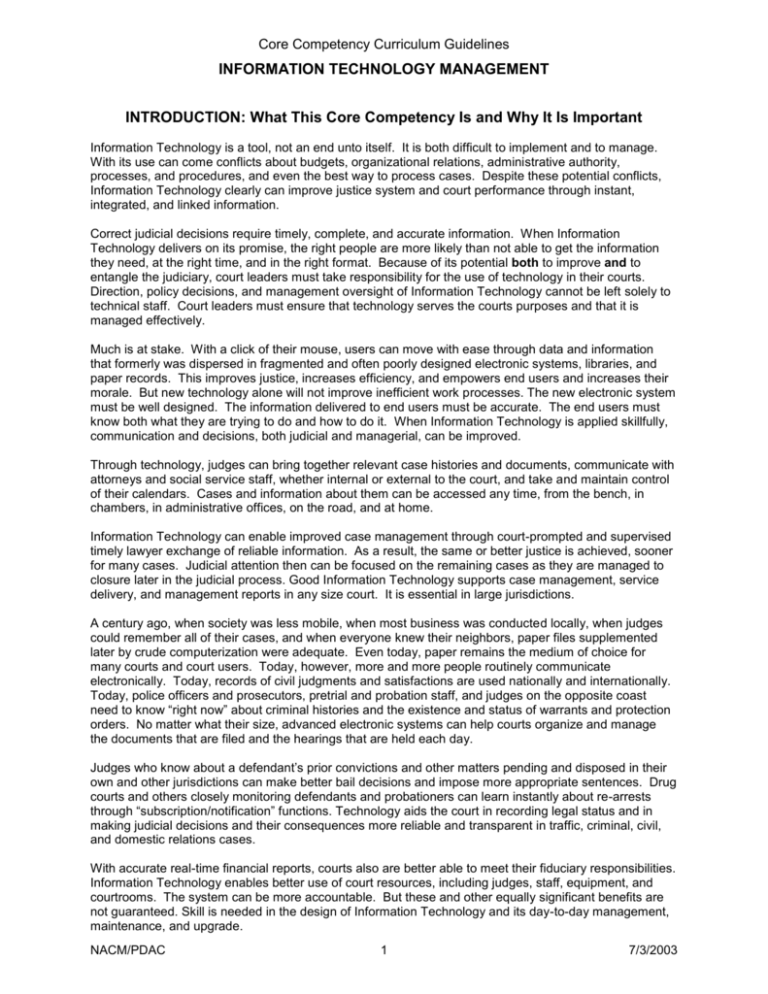
Core Competency Curriculum Guidelines INFORMATION TECHNOLOGY MANAGEMENT INTRODUCTION: What This Core Competency Is and Why It Is Important Information Technology is a tool, not an end unto itself. It is both difficult to implement and to manage. With its use can come conflicts about budgets, organizational relations, administrative authority, processes, and procedures, and even the best way to process cases. Despite these potential conflicts, Information Technology clearly can improve justice system and court performance through instant, integrated, and linked information. Correct judicial decisions require timely, complete, and accurate information. When Information Technology delivers on its promise, the right people are more likely than not able to get the information they need, at the right time, and in the right format. Because of its potential both to improve and to entangle the judiciary, court leaders must take responsibility for the use of technology in their courts. Direction, policy decisions, and management oversight of Information Technology cannot be left solely to technical staff. Court leaders must ensure that technology serves the courts purposes and that it is managed effectively. Much is at stake. With a click of their mouse, users can move with ease through data and information that formerly was dispersed in fragmented and often poorly designed electronic systems, libraries, and paper records. This improves justice, increases efficiency, and empowers end users and increases their morale. But new technology alone will not improve inefficient work processes. The new electronic system must be well designed. The information delivered to end users must be accurate. The end users must know both what they are trying to do and how to do it. When Information Technology is applied skillfully, communication and decisions, both judicial and managerial, can be improved. Through technology, judges can bring together relevant case histories and documents, communicate with attorneys and social service staff, whether internal or external to the court, and take and maintain control of their calendars. Cases and information about them can be accessed any time, from the bench, in chambers, in administrative offices, on the road, and at home. Information Technology can enable improved case management through court-prompted and supervised timely lawyer exchange of reliable information. As a result, the same or better justice is achieved, sooner for many cases. Judicial attention then can be focused on the remaining cases as they are managed to closure later in the judicial process. Good Information Technology supports case management, service delivery, and management reports in any size court. It is essential in large jurisdictions. A century ago, when society was less mobile, when most business was conducted locally, when judges could remember all of their cases, and when everyone knew their neighbors, paper files supplemented later by crude computerization were adequate. Even today, paper remains the medium of choice for many courts and court users. Today, however, more and more people routinely communicate electronically. Today, records of civil judgments and satisfactions are used nationally and internationally. Today, police officers and prosecutors, pretrial and probation staff, and judges on the opposite coast need to know “right now” about criminal histories and the existence and status of warrants and protection orders. No matter what their size, advanced electronic systems can help courts organize and manage the documents that are filed and the hearings that are held each day. Judges who know about a defendant’s prior convictions and other matters pending and disposed in their own and other jurisdictions can make better bail decisions and impose more appropriate sentences. Drug courts and others closely monitoring defendants and probationers can learn instantly about re-arrests through “subscription/notification” functions. Technology aids the court in recording legal status and in making judicial decisions and their consequences more reliable and transparent in traffic, criminal, civil, and domestic relations cases. With accurate real-time financial reports, courts also are better able to meet their fiduciary responsibilities. Information Technology enables better use of court resources, including judges, staff, equipment, and courtrooms. The system can be more accountable. But these and other equally significant benefits are not guaranteed. Skill is needed in the design of Information Technology and its day-to-day management, maintenance, and upgrade. NACM/PDAC 1 7/3/2003 Core Competency Curriculum Guidelines INFORMATION TECHNOLOGY MANAGEMENT System design; expectations of efficient and instant service; significant changes in people’s mobility and the social, political, and economic environment; and caseload volume and complexity challenge all courts. As courts deploy technology to meet these challenges, other issues arise: Technology changes rapidly while technology design and implementation can take time. Resulting applications can be dated almost as soon as they are implemented. Technology often is overlaid incrementally on complex and archaic procedures and processes. It is difficult and sometimes impractical to mirror the full complexity of justice system and court processes in information systems. Although the same rules and procedures may govern courts within a state, the size of the court, the nature of the facility and local legal culture, among other factors, drive differences in specialization and the division of labor among staff. One-size-fits-all solutions do not work. Many key components of information management systems, people, processes, data, and facilities are already in place. New hardware and software often are introduced without adequate attention to how they fit within this existing environment. Almost always, re-engineering of justice system and court business processes and training are needed. Expectations about court software are commonly unrealistic. Software developed by court staff usually has limitations. World-class designers are not available at salaries courts can afford. Because courts are a small market for software designers, finding vendors whose court products are world-class and whose financial base is strong enough to maintain the software’s currency and functionality also is problematic. Information Technology is carried out in a variety of settings. In some court systems, technology services come from an external organization with no direct reporting relationship to leaders in the courts using the systems. A county information technology group or the state court administrator’s office may be responsible for technology support of the trial court. Leaders in other trial courts directly supervise technology staff, vendors, resources, and projects. If the promise of technology is to be real rather than imagined, all these alternative organizational arrangements, and any other variant, demand skilled leadership and supervision. Managing technology requires some degree of technical competence. A court leader must be comfortable with and have some proficiency with Information Technology, because it is impossible to manage that which one does not adequately understand. Increasingly, courts are moving closer to a paperless environment, when the entire case, including all of the data, documents, recordings and transcripts of hearings, evidence, and legal reference materials will be digital. Court leaders need to keep pace with technologies such as: digital audio and video recording, video teleconferencing, voice recognition, the Internet, laptops, imaging, electronic mail and calendars, integrated justice software, alternative hardware architecture, assistive listening devices, electronic evidence presentation, and high-tech security in the courtroom and in the courthouse. Integration of court technology with other justice organizations enables open, smooth, and timely information flow. Technology can improve the speed, consistency, and fairness of decisions. Improvement in a court’s management can be dramatic. Court leaders who effectively manage Information Technology know both the limitations and the challenges it presents. They also know that if its promise is realized, Information Technology can improve justice and court efficiency and increase public trust and confidence. NACM/PDAC 2 7/3/2003 Core Competency Curriculum Guidelines INFORMATION TECHNOLOGY MANAGEMENT CURRICULUM GUIDELINES SUMMARY What Court Leaders Need to Know and Be Able To Do The five interrelated Information Technology Management Curriculum Guidelines are: Court Purposes and Processes Vision and Leadership Fundamentals Technology Management Projects Court Purposes and Processes Information Technology must honor due process and equal protection, independence and impartiality, and the roles that courts and other organizations in the justice system properly play. For example, technology applications should not give prosecutors better access to information than criminal defense lawyers, either public or private. Lawyers representing corporations, the wealthy, and the poor and the self-represented all must be served by court technology. Information Technology encompasses the people who use the system, their interdependent relationships and workflows, the information they provide to the application, and the interdependent but conflicting norms and business rules that guide their actions. Even in courts implementing therapeutic problem solving paradigms, the judicial process presupposes adversaries and conflicting roles as a means to finding the truth and achieving justice. As a result, analysis and redesign of caseflow and other work processes that precede implementation necessarily generate conflict. Court leaders who oversee this process should ensure that it is balanced and that the process and what it produces reflect court purposes and responsibilities. Alert court leaders understand that technology must support both judicial independence and impartiality -- the proper balance between the branches of government and parties to litigation-- and their interdependence and need to work with others. They do not allow technology to compromise the judicial process or bedrock political and legal principles. Vision and Leadership Leaders with vision understand their court’s current technology capacity and where that capacity can and should be improved. They set the tone and drive the pace of the system’s use of technology. They work with others to create strategic vision about the use of technology in the courts and the justice system and a multi-year plan. If the current budget and staff are not equal to the vision, the courts partner with others to get what is needed to realize the shared vision. Court leaders of high-performing courts take responsibility for their court’s use of technology and the effectiveness of court applications. Their attention to technology does not ebb and flow, because system design and management are iterative processes that are never completed once and for all. They oversee technical staff and lead the court and the justice system as challenging, sometimes vexing, technical, political, fiscal, and policy issues are addressed. The need for leadership is constant. Fundamentals Every court leader must possess at least a basic understanding of technology, including both its capabilities and its limitations. The line between vision and hallucination is a fine one. Effective court leaders are realistic about what technology can do, what it will cost, how long it will take to implement, and what is involved in its maintenance and upgrade. The knowledge required to manage technology and its rate of change is considerable. Court leaders must know the fundamentals and ensure that they, and their technical staff, keep current with how other organizations, including courts, are successfully using technology. NACM/PDAC 3 7/3/2003 Core Competency Curriculum Guidelines INFORMATION TECHNOLOGY MANAGEMENT To establish and to manage expectations about technology, court leaders must know what options exist, how they are being used in courts and other organizations, and how technology is evolving. Only then can they oversee staff and vendors to ensure that the most appropriate solutions are implemented. No one can manage what he or she does not adequately understand. Technology Management Too often, inadequate management of technology and technical staff cause technology failure. Poorly run courts do not take full advantage of technology. Information Technology requires alignment of budget; judge, line, and technical staff and their training; equipment; and caseflow and other business processes. People, budgets, workflows, and applications cannot go in their own separate directions. Application of technology to court and justice operations requires that court and justice system partners work together and at a high level of detail. Automation imposes greater structure on business processes and information exchange requiring communication and collaboration to avoid unproductive conflict. For technologists to manage technology, court leaders must manage the technologists, their relationships, and the technology environment. The technical staff must be competent professionals and work well with others both inside and outside the court. If not peculiar, good technical staff are different from others in the court. They speak a different language and seek and sometimes need considerable independence. Their talents and expertise are, however, absolutely crucial. Effective leaders know how to align technology and technologists with the court and the justice system. Projects The work of an organization typically falls into one of two categories: projects and routine operations. Projects are limited-duration activities with a defined beginning and end. Operations ensure that case processing and other court functions are maintained. Projects produce new solutions. Court leaders must encourage, nurture, and manage Information Technology projects. To do this, while at the same time maintaining current operations, they must deal with budget, project scope, human resources, schedules, financial management, quality, communications, risk, and procurement. Successful court leaders are creative about finding resources for Information Technology projects. They build and oversee the staff, the control processes, and the feedback loops needed to deliver high-quality products on time and within budget. NACM/PDAC 4 7/3/2003 Core Competency Curriculum Guidelines INFORMATION TECHNOLOGY MANAGEMENT CURRICULUM GUIDELINES REQUIRED KNOWLEDGE, SKILL, AND ABILITY COURT PURPOSES AND PROCESSES VISION AND LEADERSHIP FUNDAMENTALS TECHNOLOGY MANAGEMENT PROJECTS NACM/PDAC 5 7/3/2003 Core Competency Curriculum Guidelines INFORMATION TECHNOLOGY MANAGEMENT COURT PURPOSES AND PROCESSES Information Technology must not disrupt either the proper balance between the branches, the balance between parties to litigation, or bedrock legal principles. Bedrock legal principles include due process and equal protection, the adversarial system, equal access, and independent and impartial judicial decisions. Knowledge of the Purposes and Responsibilities of Courts Curriculum Guidelines and how they apply to Information Technology Management; Knowledge of accepted purposes underlying the management of cases from filing to disposition and how they relate to court technology: 1) produce individual justice in individual cases; 2) give the appearance of individual justice in individual cases; 3) provide a forum for the resolution of legal disputes; 4) protect individuals from the arbitrary use of governmental power; 5) create a formal record of legal status; 6) deter criminal behavior; 7) rehabilitate persons convicted of crime; and 8) separate some convicted people from society; Knowledge of how courts function and their fundamental work processes for all case types; Knowledge of the importance and the nature of court records for all case types; Knowledge of the jurisdiction, structure, and management of courts and how they affect decision making about resource acquisition and allocation for court technology; Knowledge of the culture of the judiciary and the political and fiscal environment in which the court system and its constituent courts are imbedded; Ability to manage resource allocation and acquisition in ways that preserve judicial independence, essential judicial processes, and productive relationships with the other branches of government and justice agencies; Knowledge of other organizations in the justice system and how their competing roles affect intergovernmental working relationships, information exchange, and systems integration; Skill in ensuring that technology does not create an imbalance either between branches of government or between the parties to litigation and their lawyers; Knowledge of the growth of self-represented parties and the issues the self- represented present to the use of court technology; Ability to reengineer court and justice processes to take maximum advantage of technology without disrupting fundamental legal principles and rights, including due process and equal protection, independent and impartial decisions and processes, and privacy and confidentiality. NACM/PDAC 6 7/3/2003 Core Competency Curriculum Guidelines INFORMATION TECHNOLOGY MANAGEMENT VISION AND LEADERSHIP Court leaders must take responsibility for Information Technology. If the court lacks strategic vision about technology and a multi-year plan, they work with others to create them. A court leader must be able to articulate this vision, convince others inside and outside of the judicial branch to cooperate, and lead the management of political, policy, fiscal, and technical issues related to technology. They work with others to acquire sufficient resources and to oversee the analysis and improvement of the status quo. Ability to create and articulate a clear vision of how evolving technology can be applied to courts and justice systems; Ability to inspire courts and their partners to use technology to improve courts and the justice system; Knowledge of how effective information technology can empower the courts, the justice system, and the public; Knowledge of the problems that can be addressed and capacities that can be increased with court technology; Ability to assess accurately court readiness for change with respect to both the technical and human sides of change and transition; Skill in working with others to use technology to enhance the quality and timeliness of justice, to provide equal and open access to the courts, to increase the accountability of judges and other court officials, and to improve the business practices of the judicial branch and their justice partners; Ability to lead the use of technology by establishing direction and motivating, inspiring, and overcoming resistance to change; Skill in explaining the value of multi-year technology plans and investments to judges, funding authorities, and other decision makers, including those who are not entirely technologically literate; Ability to collaborate with state and local executive and legislative branches to obtain sufficient technology funding, build technology infrastructure, and integrate justice system applications; Knowledge of court technology policy issues, including data dissemination, accuracy, privacy, public access, confidentiality, ownership, and security. NACM/PDAC 7 7/3/2003 Core Competency Curriculum Guidelines INFORMATION TECHNOLOGY MANAGEMENT FUNDAMENTALS Court leaders must know the fundamentals and ensure that they and their technical staff stay current with how other organizations and courts are using technology successfully. Every court leader must appreciate both the capacities and the limitations of always-evolving technology tools. To establish and manage expectations, court leaders must know what options exist, how technology evolves, the issues that arise with the use of technology, and how to select the most appropriate solution. No one can manage what they do not adequately understand. Knowledge of approaches taken by other courts to address information technology needs and problems, as well as resources available at the national level to monitor technological developments including, among others, the National Center for State Courts (NCSC), SEARCH Group, and the Forum on the Advancement of Court Technology (FACT); Knowledge of the need for functional standards and the case management functional standards being developed by the National Consortium on Court Automation Standards through the Conference of State Court Administrators (COSCA) and NACM Joint Technology Committee (COSCA/NACM JTC); Ability to articulate court functional requirements; Knowledge of both the capacities and limitations of information technology for specific court functions and how to match competing technologies and vendors to the functional requirements of the court, its judges, and its staff; Knowledge of technology life cycles and how technology evolves through future, emerging, current, and obsolete stages; Skill in assessing architectural options including centralized and consolidated, point- to-point coordinated systems, and hub and spoke hybrid systems, among others, for hardware, applications, and operating systems in the judicial branch and justice system; Knowledge of data integration architecture options including data warehouses and data integration hubs; Knowledge of infrastructure options: facilities, computer equipment, system software, networks, telecommunications, infrastructure support staff, data, operational procedures, finances, and other components; Ability to oversee help desk problem management systems that serve end users; Knowledge of application systems including case management, financial management, jury management, administrative systems, public access, and their integration in the courts, and the hardware and software required to support these systems; Knowledge of the systems development life cycle and its evaluation, planning, procurement, development, and implementation stages; Knowledge of software engineering processes including design, coding, and testing and the role court staff plays at various points in these processes to ensure quality; Knowledge of the Internet and its implications for court technology infrastructure, user interfaces, information exchange, standards, integration, and confidentiality; Knowledge of electronic government and how to link court applications to the Internet; NACM/PDAC 8 7/3/2003 Core Competency Curriculum Guidelines INFORMATION TECHNOLOGY MANAGEMENT Knowledge of the need for court disaster recovery contingency planning and how to put disaster recovery plans in place; Knowledge of office automation technologies including electronic mail, word processing, spreadsheets, Internet access, and database tools and their application in the court environment; Knowledge of integrated document management and records management technologies used to store, index, and retrieve active and archival court records including imaging, document management, and electronic filing; Knowledge of technologies for facilitating and capturing verbatim records of court proceedings including audio and video recording, court reporting technologies, videoconferencing, assisted listening devices, and language interpretation and translation and their potential to expedite and improve trial and appellate processes; Knowledge of technologies used to display and preserve evidence presented in the courtroom including document cameras, PC simulations, and projection systems; Knowledge of technologies used to organize and access statutes, rules, court opinions, and other legal works including online legal research databases, CD-ROM legal collections, and Internet services; Knowledge of other technologies necessary to support court operations including security, facilities management, telephones, and photocopy; Knowledge of alternative policies and issues surrounding security, privacy and confidentiality, public access, electronic and otherwise, and the need for written policies in these areas. NACM/PDAC 9 7/3/2003 Core Competency Curriculum Guidelines INFORMATION TECHNOLOGY MANAGEMENT TECHNOLOGY MANAGEMENT Well-managed courts make good use of Information Technology. Automation requires courts and others work more closely and at new levels of detail. This creates tension and requires superior management, delegation, and communication. The quality of technical staff is critical and the market for them makes it difficult for courts to compete. But for even highly qualified court technologists to be effective, court leaders must manage the technologists. Talented court leaders know how to blend technical staff into the court and justice system, achieve common understandings and, very importantly, ensure that technical staff service and support those who do the court’s work. Budget, staff, equipment, and caseflow and other business processes must be aligned. Knowledge that success with court technology depends as much on the management of people and work processes as it does on the quality of the tools; Ability to attract, develop, and retain good court technical staff; Ability to lead and manage technical people, whether in-house, central judicial (e.g., state administrative office), executive branch, outsourced, or contractual; Ability to anticipate and resolve the problems that judges and operational staff will have with the introduction of new technology; Skill in working with agencies and organizations in the justice system to produce or to implement standards for application integration and data exchange, including remote access, electronic reporting, and workflow; Ability to work with technologists to maintain and improve court operations, including case management, facilities and their modification, data conversion strategies, start-up plans, and operational procedures; Skill in writing, speaking, listening, presenting, media relations, and meeting management as they relate to oversight of technology and technical staff supporting court operations; Ability to develop and maintain communication plans and information distribution methods concerning technology for stakeholders, insiders and outsiders, including judicial officers, funding authorities, and those who process cases and manage other court functions; Skill in setting goals, evaluating options, and monitoring the work of technologists to maintain and improve the acquisition, development, and use of court technology; Knowledge of how to provide effective user support for court technology applications, including training, documentation, and quality assurance; Skill in aligning budgets, technology, court workflows, judges, other staff, and technologists. NACM/PDAC 10 7/3/2003 Core Competency Curriculum Guidelines INFORMATION TECHNOLOGY MANAGEMENT PROJECTS Projects create something that was not there before. In projects, court leaders must deal with budgets, project scope, staffing, schedules, financial management, quality, communications, risk, and procurement. Court leaders must also make sure on-going operations are balanced with the need to upgrade current systems through projects. Courts must be able to build the staff, the vendor and outsource resources, the control processes, and the feedback loops necessary to deliver high-quality products on time and within budget. Ability to assess the availability, cost, risk, and value of current court technology as it changes in different stages of technology life cycles; Knowledge of alternatives ways of funding court technology projects and upgrades, including private/public partnerships, bonds, and lease and buy back options; Knowledge of project lifecycles and the importance of dividing projects into phases with discrete deliverables and management controls; Ability to organize and develop management and technical teams to conduct project work without comprising on-going operations; Ability to identify and work with stakeholders and the individuals and organizations that are actively involved in or affected by a court technology project; Skill in using diverse procurement approaches, managing project procurement, including procurement planning, solicitation planning, solicitation including request for information (RFI) and request for proposals (RFP), vendor or product selection, and contract development, administration, implementation, and closeout; Skill in evaluating the substance of vendor responses to Requests for Information (RFI) and Requests for Proposals (RFP) before signing a contract; Expertise with project management tools and techniques, including project plan development and execution, change management, monitoring implementation and project milestones, and project closeout; Knowledge of risk management practices in court technology projects, including risk identification and quantification, response and contingency planning, development of reserves, and restrictive contract language. Skill in applying the tools and techniques of project management to define the scope of court projects, to negotiate formal acceptance of the scope with stakeholders, and to manage needed changes in scope and deliverables throughout a project; Skill in defining project activities, sequencing tasks, estimating the duration of work, developing schedules, and managing schedule changes during the project life cycle; Skill in overseeing planning, monitoring, and testing the quality of interim and final products to ensure that systems developed during court technology projects meet court specifications and functional requirements. NACM/PDAC 11 7/3/2003




